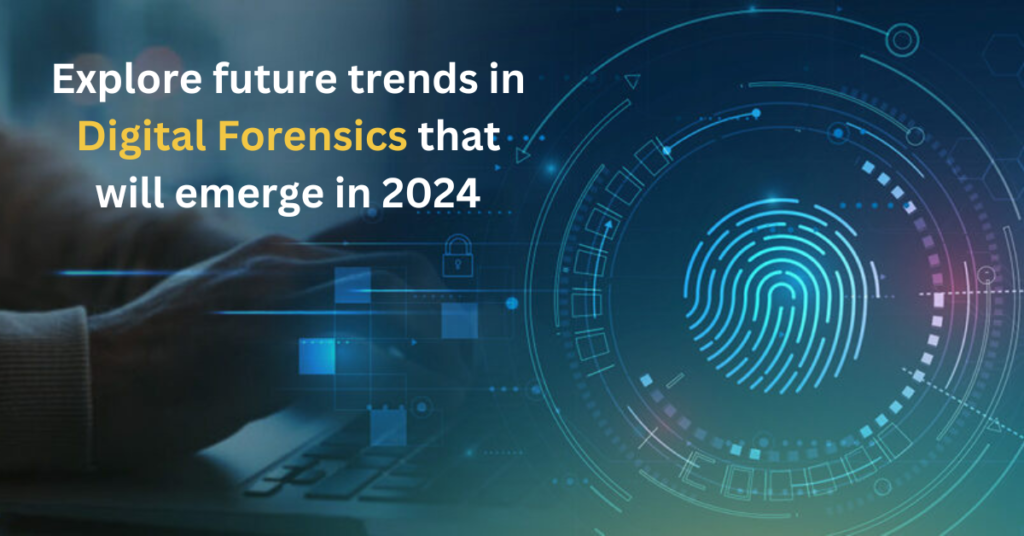
What are Digital Forensics? Explore future trends in Digital Forensics that will emerge in 2024!
Reading Time: 3 minutesDigital forensics, often referred to as computer forensics, is a branch of forensic science that involves the collection, analysis, and preservation of electronic evidence in order to investigate and prevent digital crimes. Digital forensics encompasses a wide range of activities, and its primary goal is to uncover and preserve evidence from electronic devices and digital media for legal purposes.
Here are some key aspects of digital forensics:
- Evidence Collection: Digital forensics involves the systematic collection of electronic evidence from various sources, including computers, mobile devices, servers, and storage media. This evidence can include files, emails, logs, metadata, and more.
- Analysis: Once the evidence is collected, digital forensics experts analyze the data to reconstruct events, identify patterns, and extract relevant information. This analysis may involve the use of specialized tools and techniques to examine both the content and the structure of digital artifacts.
- Preservation: It is crucial to preserve the integrity of digital evidence throughout the investigative process. Digital forensics professionals use specialized methods to create forensic copies of data, ensuring that the original evidence remains unaltered and admissible in a court of law.
- Recovery: Digital forensics often involves the recovery of deleted or hidden data. Forensic experts use advanced tools and methods to retrieve information that may have been intentionally or accidentally removed from storage devices.
- Chain of Custody: Maintaining a proper chain of custody is essential in digital forensics. This involves documenting the handling, storage, and transfer of evidence to ensure its integrity and reliability in legal proceedings.
- Incident Response: Digital forensics is often a crucial component of incident response efforts. When a cybersecurity incident occurs, forensic experts work to identify the scope of the incident, trace the origins of the attack, and gather evidence to support remediation and legal action.
- Legal Considerations: Digital forensics is conducted with a keen awareness of legal and ethical considerations. Evidence collected must adhere to legal standards, and the forensic process should be conducted in a manner that ensures the admissibility of the evidence in a court of law.
- Specialized Areas: Digital forensics covers a wide range of specialized areas, including mobile forensics, network forensics, memory forensics, and forensic analysis of specific types of data such as images, videos, or databases.
Digital forensics is commonly employed in investigations related to cybercrime, data breaches, intellectual property theft, fraud, and other offenses involving electronic devices. Professionals in this field often work in law enforcement, corporate security, government agencies, or as independent consultants. The field is dynamic, evolving in response to advancements in technology and the changing landscape of digital threats.
ICSS can see some educated predictions on potential trends in digital forensics that might emerge in 2024 based on the trajectory of the field. Keep in mind that the actual developments may vary, and it’s essential to stay updated with the latest information. Please find some potential trends:
Blockchain and Cryptocurrency Investigations:
As the use of blockchain and cryptocurrencies continues to rise, digital forensics will likely see an increased focus on investigating transactions, wallet addresses, and other activities related to digital assets.
IoT Forensics:
With the proliferation of Internet of Things (IoT) devices, investigators may need to adapt to new challenges in collecting and analyzing digital evidence from a diverse range of connected devices, such as smart home devices, wearables, and industrial IoT systems.
Artificial Intelligence in Digital Forensics:
AI tools could play a more significant role in automating certain aspects of digital forensics, helping analysts process and analyze large datasets more efficiently. Machine learning algorithms might be used to identify patterns and anomalies in digital evidence.
Cloud Forensics:
As more organizations transition to cloud-based services, digital forensics will need to evolve to handle investigations involving cloud storage, applications, and virtualized environments. This includes addressing challenges related to data privacy, jurisdiction, and the dynamic nature of cloud services.
Privacy Challenges and Compliance:
Digital forensics professionals may face increased challenges related to privacy concerns and evolving data protection regulations. Compliance with laws such as GDPR (General Data Protection Regulation) and similar legislation worldwide will be crucial in the handling of digital evidence.
Enhanced Mobile Forensics:
As smartphones and mobile devices continue to be a primary source of digital evidence, advancements in mobile forensics tools and techniques can be expected. This includes improved capabilities for extracting data from encrypted devices and apps.
Cyber Threat Intelligence Integration:
Collaborations between digital forensics and cyber threat intelligence teams may become more integrated. This integration can help organizations better understand the threat landscape, attributing attacks, and proactively defending against emerging cyber threats.
Deepfake and Multimedia Forensics:
As deepfake technology advances, the need for digital forensics to authenticate multimedia content and identify manipulated or synthetic media will likely grow. Techniques for detecting deepfakes and ensuring the integrity of digital images and videos will be crucial.
Remote Digital Forensics:
The increasing prevalence of remote work may lead to a rise in remote digital forensics capabilities. Tools and methodologies for conducting digital investigations without physical access to the devices involved may become more important.
Cross-Border Collaboration:
With the global nature of cybercrime, digital forensics teams may need to enhance their collaboration and information-sharing practices across borders to effectively combat cyber threats.
Keep in mind that the field of digital forensics is dynamic, and these trends are speculative. Staying informed through professional organizations, conferences, and continuous learning is essential for professionals in this field.